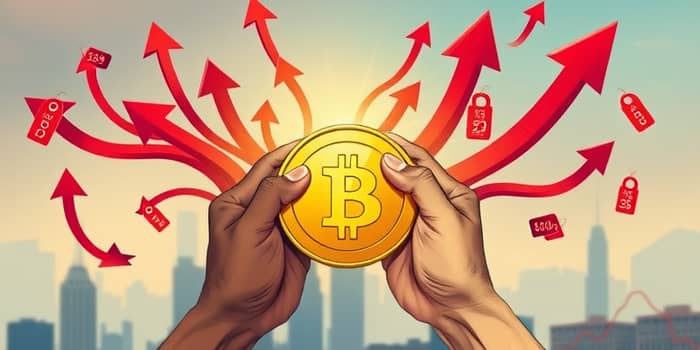Inflation shapes economic landscapes and influences every financial decision we make. When prices across goods and services rise, each dollar in our pocket loses value, making it critical to adopt informed strategies. In this article, we explore the concept of inflation, uncover its causes and effects, and offer concrete steps to shield your hard-earned wealth. By gaining clarity on these issues, you’ll be equipped to protect and even grow your financial standing, despite rising costs and economic uncertainty.
What is Inflation and Why It Matters?
At its core, inflation represents the rate at which general prices increase, eroding the purchasing power of money over time. In practical terms, when inflation is at 3% annually, an item costing $100 today will cost $103 next year. This gradual climb affects everything from groceries to gasoline, making everyday expenses steadily higher.
By contrast, deflation occurs when prices fall, often signaling economic contraction and decreased consumer spending. Both inflation and deflation pose challenges, but moderate inflation is typically desired to encourage investment and consumption, safeguarding economic growth and job creation.
Causes and Types of Inflation
- Demand-pull inflation emerges when consumer demand outstrips available supply, common during economic recoveries or stimulus-induced spending sprees.
- Cost-push inflation arises from rising production costs, such as spikes in oil prices or labor shortages, shifting higher expenses onto consumers.
- Built-in inflation reflects escalating expectations of future price increases, fueling a cycle of wage hikes and price adjustments.
Key drivers include monetary policy decisions—where central banks expand the money supply to stimulate the economy—and external supply shocks like natural disasters or geopolitical tensions. Currency depreciation and higher import tariffs further contribute by making foreign goods more expensive, amplifying price pressures at home.
Measuring Inflation
Policymakers and economists rely on specific indices to track inflation accurately. The most widely cited indicator is the Consumer Price Index (CPI), which measures the average change in prices paid by consumers for a representative basket of goods and services. Other benchmarks include the Producer Price Index (PPI) and core inflation, which excludes volatile food and energy costs to reveal underlying trends.
Notably, U.S. CPI peaked above 9% year-over-year in 2022—the highest since the early 1980s—driven by post-pandemic supply disruptions and surging energy costs. Understanding these metrics helps individuals and institutions anticipate policy actions, such as interest rate adjustments, and plan accordingly.
Effects of Inflation on Everyday Life
- Reduced purchasing power means salaries no longer stretch as far, affecting household budgets.
- Real investment returns can be eroded if asset growth fails to outpace the inflation rate.
- Higher interest rates raise borrowing costs on mortgages, auto loans, and credit cards.
- Wage-price spirals intensify inflation as workers demand higher pay to keep up with rising costs.
Consumers often face tough choices: cutting discretionary spending, delaying big purchases, or relying on credit. Meanwhile, savers watch the real value of deposits diminish unless interest earnings exceed inflation—a rare occurrence in many traditional savings accounts.
Strategies to Safeguard Your Purchasing Power
Defensive financial planning can blunt inflation’s impact. Start with establishing an emergency fund in a high-yield savings account or money market fund to preserve liquidity and earn modest returns above inflation.
- Consider Certificates of Deposit (CDs) or share certificates offering fixed rates for set terms.
- Pay down high-interest, variable-rate debts—particularly credit card balances—to reduce vulnerability to rising rates.
- Lock in low-interest, fixed-rate mortgages when possible, turning inflation into an ally against your loan’s real value.
On the investment front, diversify across asset classes known for inflation-beating performance. Treasury Inflation-Protected Securities (TIPS) adjust principal with CPI changes, while commodities like precious metals and agricultural products often track or outpace inflationary trends. Real estate and hard assets—including farmland and collectibles—tend to hold intrinsic value, offering another layer of protection.
Policy Responses and the Road Ahead
Central banks wield interest rate hikes as their primary tool to curb inflation, aiming to cool demand without triggering a severe downturn. Governments may adopt fiscal restraint, trimming budgets to ease upward price pressures, though such measures can be politically challenging during crises.
Supply-side interventions—like expanding infrastructure, diversifying trade partnerships, or investing in renewable energy—seek to bolster production capacity over the long term. Clear communication from policymakers is also crucial to anchor expectations and prevent a self-fulfilling inflation cycle.
Key Takeaways and Action Steps
Inflation is an ever-present force that demands respect and proactive management. By understanding its root causes and adopting targeted strategies—from high-yield savings to diversified portfolios—you can maintain and even grow your purchasing power. Regularly review your budget, monitor economic indicators, and stay flexible in your financial planning. With vigilance and informed decisions, you can turn the challenge of inflation into an opportunity for resilience and growth.
References
- https://www.pgpf.org/article/what-is-inflation-and-why-does-it-matter/
- https://www.range.com/blog/inflation-5-wealth-protection-strategies
- https://www.rosenbergresearch.com/2025/05/26/understanding-inflation-causes-effects-and-solutions/
- https://www.alliancebernstein.com/us/en-us/investments/ab-market-views/how-to-protect-your-clients-from-inflation.html
- https://www.independent.org/article/inflation-causes/
- https://www.unfcu.org/financial-wellness/protect-your-money-during-high-inflation/
- https://www.imf.org/en/Publications/fandd/issues/Series/Back-to-Basics/Inflation
- https://www.finhabits.com/how-does-inflation-affect-savings-and-how-to-protect-your-money/










